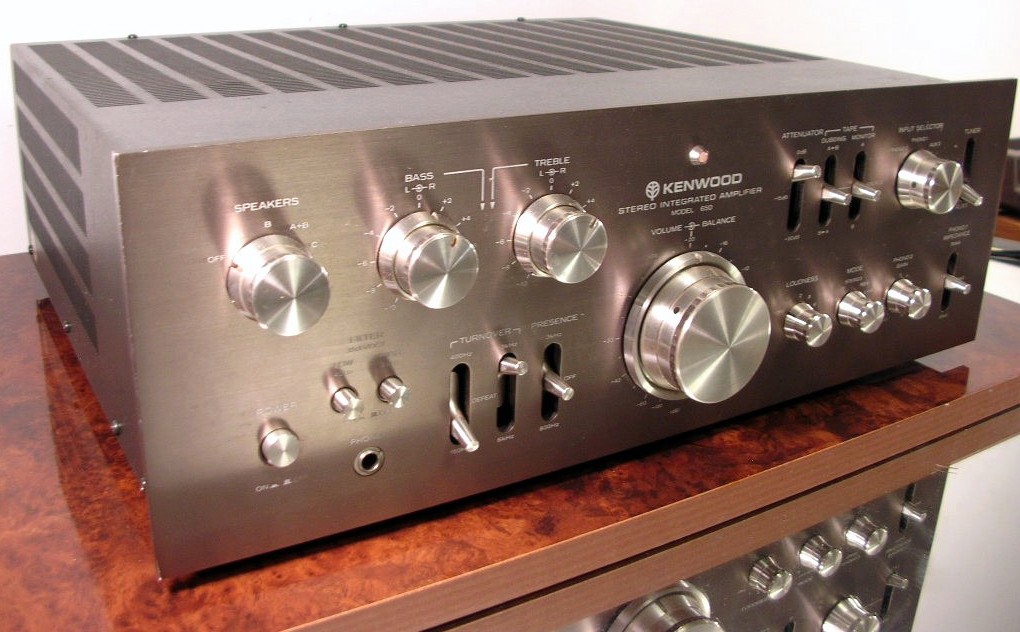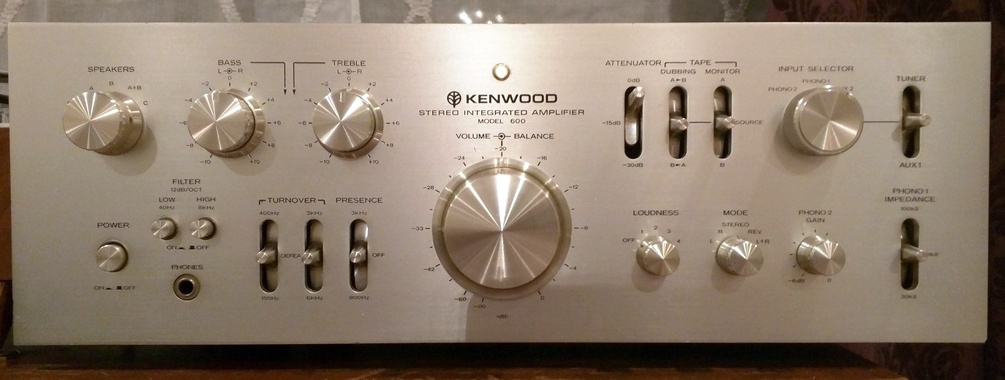Difference between revisions of "Kenwood Model 650"
Analoghatwas (talk | contribs) m (→Links: Schreibf. korr.) |
|||
| (9 intermediate revisions by 2 users not shown) | |||
| Line 1: | Line 1: | ||
__NOTOC__ | __NOTOC__ | ||
| − | == | + | == Data == |
| − | {{ | + | {{navigation}} |
| − | ''' | + | '''General''' |
| − | * | + | * Manufacturer: [[Kenwood]] |
| − | * | + | * Model: Model 650 (identical Model 600, but with bronze-colored front) |
| − | * | + | Type: Stereo integrated amplifier |
| − | * | + | * Years of manufacture: 1975 - 1979 |
| − | * | + | * Made in: Japan |
| − | * | + | * Color: Bronze |
| − | + | * Power consumption: 790 W max. | |
| − | * | + | * Dimensions (WxHxD): 440 x 154 x 388 mm |
| − | * | + | * Weight: 21.3 kg |
| − | * | + | * Original price approx.: 2'298 DM |
| − | ''' | + | '''Connections''' |
| − | * | + | * Number of inputs: |
| − | ** | + | ** Input sensitivity: |
| − | ** Phone 1 MM: 2.5mV, 30 kOhm, 60 kOhm, 100 kOhm, max. | + | ** Phone 1 MM: 2.5mV, 30 kOhm, 60 kOhm, 100 kOhm, max 220mV. |
| − | ** Phone 2 MM: 2.5 - 5mV, | + | ** Phone 2 MM: 2.5 - 5mV, adjustable, 50 kOhm, max. 220mV |
** Tuner: 150mV, 50 kOhm | ** Tuner: 150mV, 50 kOhm | ||
** AUX 1,2: 150mV, 50 kOhm | ** AUX 1,2: 150mV, 50 kOhm | ||
** Tape Play A, B: 150mV, 50 kOhm | ** Tape Play A, B: 150mV, 50 kOhm | ||
| − | * | + | * Number of outputs: |
| − | ** | + | ** Outputs: |
** Line: 150mV, 80 kOhm | ** Line: 150mV, 80 kOhm | ||
| − | + | DIN: 80mV, 150 kOhm | |
| − | ** | + | ** Headphones |
| − | ''' | + | '''Technical Data''' |
| − | * | + | * Continuous power (at THD) |
| − | ** 8 Ohm: 2x 130W (RMS, | + | ** 8 Ohm: 2x 130W (RMS, 20 Hz ... 20 kHz, 0.08% THD), 2x 135W (8 Ohm, 1kHz) |
| − | ** 4 Ohm: 2x 150W (4 Ohm, | + | ** 4 Ohm: 2x 150W (4 Ohm, 1kHz) |
| − | * | + | * Dynamic power |
** 8 Ohm: | ** 8 Ohm: | ||
** 4 Ohm: 640 W | ** 4 Ohm: 640 W | ||
| − | * | + | * Total harmonic distortion: 0.08% THD at 8 Ohm |
| − | * | + | * Attenuation factor: 50 at 8 Ohm |
| − | * | + | * Frequency response: 5 Hz - 50 kHz |
| − | * | + | * Signal-to-noise ratio: |
** 76dB (MM) | ** 76dB (MM) | ||
| − | + | 90dB (Line) | |
| − | * | + | * Tone control |
** Bass: | ** Bass: | ||
| − | *** 150Hz : ± 7 | + | *** 150Hz : ± 7.5dB at 40Hz |
| − | *** 400Hz : ± 7 | + | *** 400Hz : ± 7.5dB at 100Hz |
| − | + | Treble: | |
| − | *** 3Khz : ± 7 | + | *** 3Khz : ± 7.5dB at 10Khz |
| − | *** 6Khz : ± 7 | + | *** 6Khz : ± 7.5dB at 20Khz |
| − | + | Loudness (-30dB) : +2 / +4 / +6 / +8dB at 100Hz | |
* High Filter: 8Khz, 12dB/octave | * High Filter: 8Khz, 12dB/octave | ||
* Low Filter: 40Hz, 12dB/octave | * Low Filter: 40Hz, 12dB/octave | ||
| Line 58: | Line 58: | ||
| − | ''' | + | '''Special Features''' |
| − | * | + | * Power attenuator: 0 dB, -15 dB, -30 dB |
| − | * Loudness 4- | + | * Loudness 4-stage |
| − | * | + | * Pre- and power amplifier separable |
| − | == | + | == Notes == |
| − | + | * Other models of the same series: | |
| − | * | + | * Amplifier |
| − | * | + | * [[Kenwood Model 500]] |
| + | * [[Kenwood Model 600]] | ||
| + | * [[Kenwood Model 650]] | ||
| − | |||
| − | + | * [[Tuner | |
| − | * | + | * [[Kenwood Model 600 T]] |
| − | [[ | + | * [[Kenwood Model 650 T]] |
| − | |||
| − | |||
| + | * Kenwood recommended speakers for: | ||
| + | * [[Kenwood Model Seven]] | ||
| − | == | + | |
| − | * | + | == Pictures == |
| + | * Picture: Kenwood Model 650 | ||
| + | [[File:Kenwood Model 650-1.jpg]] | ||
| + | |||
| + | |||
| + | * Picture: The identical amplifier was also available with a silver-coloured front as Kenwood Model 600 | ||
| + | [[File:Kenwood Model 600-1.jpg]] | ||
| + | |||
| + | |||
| + | == Reviews == | ||
| + | * Review from Good Old Hifi: [http://www.good-old-hifi.de/kenwood_model_600/] | ||
| + | |||
| + | * Report from "Mackers": [http://www.mackern.de/index.php/2009/03/13/triokenwood-supreme-600/] | ||
== Links == | == Links == | ||
| − | * | + | * External link to website "Hifi Studio": [https://web.archive.org/web/20160410044957/http://www.hifi-studio.de/hifi-klassiker/kenwood/Kenwood_600T-600/Kenwood_600.htm] |
| − | * | + | * External link on website "The Vintage Knob", including a picture of the setup: [http://www.thevintageknob.org/kenwood-Model_600.html], retrieved 13 January 2018. |
| − | [[ | + | [[Category:Integrated amplifier]] |
Latest revision as of 04:10, 5 April 2020
Data
General
- Manufacturer: Kenwood
- Model: Model 650 (identical Model 600, but with bronze-colored front)
Type: Stereo integrated amplifier
- Years of manufacture: 1975 - 1979
- Made in: Japan
- Color: Bronze
- Power consumption: 790 W max.
- Dimensions (WxHxD): 440 x 154 x 388 mm
- Weight: 21.3 kg
- Original price approx.: 2'298 DM
Connections
- Number of inputs:
- Input sensitivity:
- Phone 1 MM: 2.5mV, 30 kOhm, 60 kOhm, 100 kOhm, max 220mV.
- Phone 2 MM: 2.5 - 5mV, adjustable, 50 kOhm, max. 220mV
- Tuner: 150mV, 50 kOhm
- AUX 1,2: 150mV, 50 kOhm
- Tape Play A, B: 150mV, 50 kOhm
- Number of outputs:
- Outputs:
- Line: 150mV, 80 kOhm
DIN: 80mV, 150 kOhm
- Headphones
Technical Data
- Continuous power (at THD)
- 8 Ohm: 2x 130W (RMS, 20 Hz ... 20 kHz, 0.08% THD), 2x 135W (8 Ohm, 1kHz)
- 4 Ohm: 2x 150W (4 Ohm, 1kHz)
- Dynamic power
- 8 Ohm:
- 4 Ohm: 640 W
- Total harmonic distortion: 0.08% THD at 8 Ohm
- Attenuation factor: 50 at 8 Ohm
- Frequency response: 5 Hz - 50 kHz
- Signal-to-noise ratio:
- 76dB (MM)
90dB (Line)
- Tone control
- Bass:
- 150Hz : ± 7.5dB at 40Hz
- 400Hz : ± 7.5dB at 100Hz
- Bass:
Treble:
- 3Khz : ± 7.5dB at 10Khz
- 6Khz : ± 7.5dB at 20Khz
Loudness (-30dB) : +2 / +4 / +6 / +8dB at 100Hz
- High Filter: 8Khz, 12dB/octave
- Low Filter: 40Hz, 12dB/octave
- Presence :
- +6dB at 800Hz
- +6dB at 3Khz
Special Features
- Power attenuator: 0 dB, -15 dB, -30 dB
- Loudness 4-stage
- Pre- and power amplifier separable
Notes
- Other models of the same series:
- Amplifier
- Kenwood Model 500
- Kenwood Model 600
- Kenwood Model 650
- Kenwood recommended speakers for:
- Kenwood Model Seven
Pictures
- Picture: Kenwood Model 650
- Picture: The identical amplifier was also available with a silver-coloured front as Kenwood Model 600
Reviews
- Review from Good Old Hifi: [1]
- Report from "Mackers": [2]
Links
- External link to website "Hifi Studio": [3]
- External link on website "The Vintage Knob", including a picture of the setup: [4], retrieved 13 January 2018.

